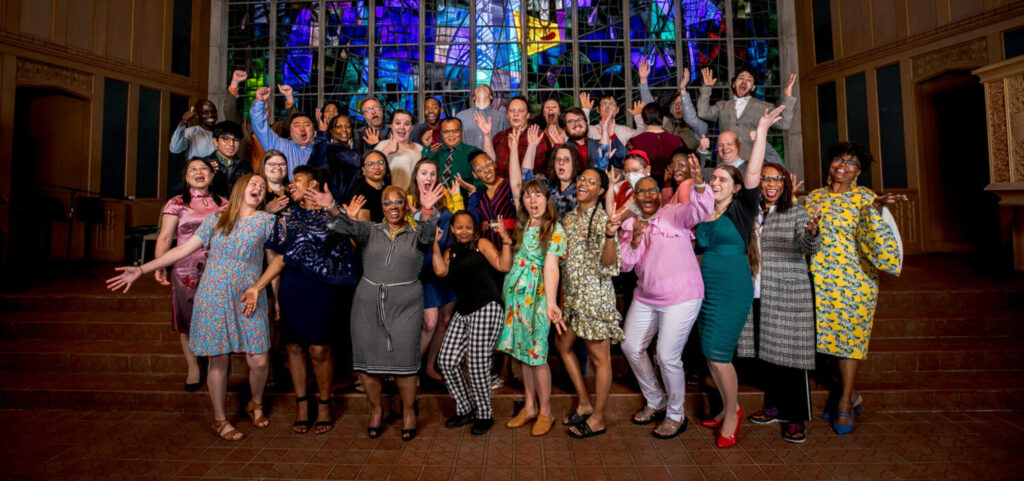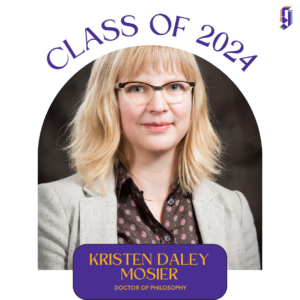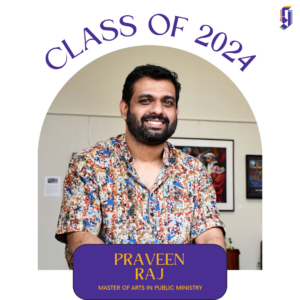
Join us for our 168th Commencement at the Alice Millar Chapel, 1870 Sheridan Road, Evanston, on May 17 from 9 – 11 AM and the reception will take place at Rector Terrace (weather permitting) and Loder Hall, 2121 Sheridan Road, Evanston, immediately following the commencement ceremony.
Dr. Eboo Patel will be the speaker for the commencement ceremony. Eboo Patel is a civic leader who believes that religious diversity is an essential and inspiring dimension of American democracy. Named “one of America’s best leaders” by U.S. News and World Report, Eboo is Founder and President of Interfaith America, the leading interfaith organization in the United States. Under his leadership, Interfaith America has worked with governments, universities, private companies, and civic organizations to make faith a bridge of cooperation rather than a barrier of division.
Want to learn more about our graduating class? Read our interviews with some of the members of the class of 2024!

Jessica Hopkins speaks quickly, passion bursting, as she describes her studies at Garrett. Graduating this May with a Masters of Arts in Public Ministry, time in seminary offered space to explore her own Choctaw heritage while simultaneously learning about the gifts that indigenous theologies can bestow on a traumatized Earth and people. “I’ve been exploring the impact of the Doctrine of Discovery, Manifest Destiny and historical trauma,” she begins. “Not just on our legal systems, but the ways those forces traumatized indigenous communities and especially indigenous bodies.” She makes clear, however, that this history cannot be separated from harm against ecosystems. “Healing and identity are rooted in nature as well as self,” Hopkins explains. “So healing bodies also means healing nature.”
While she’s now passionate about indigenous and eco-theologies’ promise to start unwinding this violence, she confesses that this was not her mindset when she began her seminary journey. “I came to Garrett really cynical and apathetic,” Hopkins says. “I graduated college after the election, after COVID—under the theft of people’s rights—everything that’s happened in the past few years. I didn’t know what I believed in anymore.” Encountering indigenous scholarship in the classroom, however, helped return her to her own body—offering hope that didn’t ignore the impact of colonial violence, but also refused to let oppressive forces have the final word. “I’m pretty sure in every class I’ve taken there was at least one indigenous source to read,” she says. “We know the history, but to see how other indigenous people are using Christian theology as a vessel for healing was so powerful.”
In her own thesis work, she wove deep incarnation—a theology developed by scholars like Elizabeth Johnson—with Mark Mooney’s eco-somatic theory, looking particularly at how these forces intersect women’s lives in relationship to the natural world. “God is enlivening creation,” she notes. “Everything is filled by the Holy Spirit—from the energy in your body to the energy throughout all life. That’s how we connect, but when we cannot feel our own spirit, we cannot create connection with nature, and that’s a source of so much suffering.” Recovery, in this framework, requires us to knit back together those relationships. “In order for healing to be fully embodied, it must include the rest of creation,” she says. “We must equally confront the extractive industry, corporate slaughterhouses, the fishing industry—all of it is deep injustice because the Creator’s Spirit appears in each animal that is slaughtered, every fish losing its home.”
As she developed this theology, Hopkins found comfort and wisdom in collaboration. “Mark Mooney was actually my field education advisor over the summer,” she exclaims with joy. “I got to meet with him quite a few times—so cool. And Dr. Eberhart helped me understand creation as more than rocks and trees and water; as an entity with its own life force.” Perhaps even more important, however, were chances she had to study in circles of wider indigeneity. “I got to travel to Healing Our Spirit Worldwide in Vancouver and NAIITS: An Indigenous Learning Community in Manitoba,” she gushes. “It was so amazing to be there, to learn from indigenous people from Taiwan, Australia, New Zealand, Norway—you name it—to focus on the process of mending, not just the harm.”
What she discovered throughout the program was a fundamentally different way to understand the world. “It’s a complete paradigm shift to consider that animals don’t only have their own right to life and habitat, but that they are creative and have feelings, too,” she observes. “Water becomes not just molecules you have to drink, but an essence with its own spirit; mountains aren’t just resources to be mined, they play a role in creating and sustaining your reality.” Changing how she viewed non-human kin helped her better know our interconnectedness. “If you lose the salmon, you lose those nutrients and you lose cultures and ways of life,” she says. “But also the river is going to decline, and as the river declines the forest will decline—a slow violence that will destroy everything we have.”
But if that interconnectedness draws our attention to what is threatened, it also calls us to see power for new life. “Indigenous people are willing to put their bodies on the line for creation as they have throughout history,” Hopkins says. “When people recognize the river, the fish, everything in creation as a brother or sister that they’re willing to die for, that’s true sacrifice and true love. There’s so much emerging deep collaboration that recognizes this is our planet; humans and Earth must start working together.”
This conviction draws her back to her own Christian faith. “Jesus didn’t go and conquer he went and lived with the community,” she explains. “It’s a call to spend time with and become part of both people and the entire web of creation that carries God’s Spirit.” This theology offers hope for healing the planet, but it’s also reciprocally helped reintegrate her own identity. “It means I don’t have to choose between being indigenous and being Christian,” she concludes. “I don’t think the Creator would ever ask anyone to choose.”

We’re familiar with water as an essential and defining feature of baptism, yet few baptismal theologies treat it like an active participant in the sacrament. For the most part, water’s role would only be noteworthy in its absence (while I’ve been in many worships that used different communion elements, I’ve never seen someone get baptized with anything else). For soon-to-be-Dr. Kristen Daley Mosier, however, this oversight disregards the sacredness of water within the ritual and contributes to theologies that diminish its worth in the rest of our lives. “As I was studying baptismal theology, it started to dawn on me that it’s all about water and yet, we’re not talking about particular waters,” the graduating Ph.D. student tells me. “I started to wonder: Why is that? And what happens when we do talk about particular waters?”
To investigate this further, she wrote her dissertation, Led Down into the Streams: a Baptismal Journey through Water and Spirit,” examining baptismal theology through a watershed lens, a process that opened new frontiers for both her understanding of the sacrament and appreciation of our ecological interconnectedness. “The work of Ched Meyers Watershed Discipleship came into play in asking, ‘What role does water play?” she says. “Not just sacramentally, but also ecologically and possibly even subjectively, as we see a shift from thinking of nature as inanimate to considering it through the notion of subjectivity—that we are partnering with water to bring persons into the community of Christ and into the Church.”
While some of these philosophical dimensions may be new, honoring water is not. “The earliest existing treatise we have was written by Tertullian,” she notes. “In it, water has this beautiful, expansive role—at one point he stops himself because he’s been talking about water so much and says, ‘Oh, but I’m not writing a theology of water,’ before I go too far with that let’s return to Jesus.’” In short order, however, the holiness of water was downplayed and diminished. “By the time Ambrose is writing, he’s saying that only water that has been consecrated can be used for baptism,” she explains. “there’s a complete separation of the waters for everyday use and for religious use—a separation we’ve inherited, made worse by the Enlightenment and many of our modern thinkers.”
While there’s nothing wrong with ritual blessing, or consecrating baptismal waters, treating ordinary water as if it were profane carries significant ecological risk. “When we minimize elements of creation within our worship spaces, we risk devaluing them altogether,” Daley Mosier explains. In the Bible, we read that water is present in God’s very act of creation. It is an integral part of creating and sustaining life in a theological sense, in addition to the quite literal one. When governments and/or corporations abuse the watershed, God’s people suffer. And that harm affects the baptismal act, too.
As part of her studies at Garrett, Daley– Mosier worked with Dr. Andrew Wymer to interview pastors in Flint, Michigan about how baptismal practices were impacted by the Flint Water Crisis. “We asked the question: Would you ever consider baptizing using water from the Flint river?” she remembers. “Very quickly they said ‘No,’ and there was usually a bit of a chortle with the ‘No,’” as if the idea of baptizing people in the community’s natural water was absurd. These issues of environmental racism and ecological injustice are too often absent in scholarly work where they should be present. “I’m reading re-wilding conversations and all this ecotheology that says, ‘let’s take our sacraments back outdoors,” she notes. “Then I hear the Flint clergy saying, ‘Our people would never get baptized in the Flint River because it has a storied history of being very unclean.’ It’s haunting.’”
Ultimately part of the work to prevent future water crises is reestablishing relationship with local watersheds. It’s a relationship to which Daley Mosier became increasingly aware throughout this academic journey. “One of the things about doing a watershed-oriented research project is that I realized just how connected I am to my own watershed—it was a primary reason that my spouse and I moved back to Seattle after I did my coursework,” she says. “My dad was a fisheries consultant, and so I grew up checking stream habitat for fish, traipsing along behind him looking for frogs.” A glow spreads across her face alongside the memory, the contentment of someone who hears and knows her call. In addition to working with two local churches, she is connecting with Earth Ministry / Washington Interfaith Power & Light to use her theological training and find ways to serve with them, and others, in advocating for environmental justice. “I know it will be a quilted career,” she says with a smile. “This is what it means to do theology in place.”

Climate change is too often discussed as an existential crisis instead of a particular threat, until the moment it becomes acutely personal. Growing up in Kerala, a state in South India, Praveen Raj reports that he used to think about ecological disaster in more general terms. “Kerala is a beautiful place,” he tells me. “Whenever people talked about global warming, I always thought about it as something happening somewhere else, not connected with us and our land.” Without warning, notions of a formless danger dramatically ended. “In 2017, ’18, and ’19, Kerala was hit by heavy floods from Monsoon change,” Raj says. “My parents’ house is in a rural area surrounded by hills, and was damaged by a landslide.” Suddenly, what was once theoretical caused profound and concrete harm. “On the other side of the house, they were constructing unapproved real estate, which contributed to the landslide,” he explains. “In that moment I realized, it’s not happening somewhere else, it’s here, and my theology must respond to the ongoing ecological disaster.”
When he matriculated in the Masters of Arts in Public Ministry program—from which he graduates this year—he had a different relationship to climate catastrophe, but he didn’t yet possess the analytical tools to make full sense of what he and his family suffered. “I had heard about systems of domination and capitalism, but I was not able to name those issues in particular,” Raj confesses. “Dr. Eberhart and his mentorship helped me identify structurally what is happening, and discover hope in theology. It gave me a lens to look at these issues, how they manifest in the U.S., and connect them to what is happening in India.” He became especially focused on the way climate change disproportionately affects the people who are already most vulnerable. “The courses helped connect theory and theologies of public social justice to methods and models for social change,” he says. “Once I better understood environmental racism, I was able to ask, ‘Where are they developing and at whose cost? How does this harm poor people? Who is in pain?”
By way of example, he offers a story that reveals intersecting injustices. “In one of the largest landslides, 30 to 40 people died,” Raj shares. “It was people who cannot afford housing in the city area, so poor people live on hilly terrain, working agricultural jobs, essentially bound to the land.” Because of economic desperation and precarity, the answer to this crisis cannot simply be to move somewhere else. “They have to be there,” he says. “But this is where the landslides are happening.”
In response, Raj is working with a coalition of churches to ameliorate harm, while pushing for more systemic change. The project attempts to envision a climate-resilient community-building project in Amboori, Kerala, India to facilitate an anticipatory community in the context of natural disasters, especially landslides “Even if we can’t prevent landslides on a larger scale, at least we can create a network of churches to try to stop these kinds of environmental disasters through bioengineering, vegetable gardening and permaculture,” he explains. “And when landslides do happen, the churches can give honorarium to help people survive for the time being, and to rebuild in a more sustainable way.”
The project draws inspiration from a theological framework, primarily emphasizing the theme of being ‘born-again,’ which advocates for the transformative rebirth and renewal of the community towards environmental sustainability and resilience. Central to this effort is the role of the local Church, envisioned as a pivotal agent in nurturing an anticipatory community mindset and facilitating sustainable living practices. Through this project, the Pantha community is expected to transform into a vibrant, resilient, and anticipatory community, capable of facing environmental challenges with innovative and sustainable strategies.
While the project is quite practical in nature, Raj also connects this pragmatic approach to a deeper theological need to reorient relationship with nature. “My people were introduced to Eurocentric Christianity around 200 and years ago, eliminating and classifying my ancestors’ indigenous earth-based spirituality as ‘profane.’ Before that, we were Hindus and nature was so close,” he mourns. “For them natural worship was part of that tradition. But once we were introduced to Western Christianity we were told to forget that.” Redressing ecological harm is essentially tied to work that cultivates a different spiritual life. “The present generation is now looking back to our ancestors’ worship and Earthbound spiritual practices. We need to go back to those practices to an understanding that plants and animals were part of them, given spiritual value,” Raj says. “To tackle the current ecological crisis, we need to reorient congregations and local communities toward that spiritual reconnection.”
This is where political theories of decolonization meet theologies that fuel change. “We are healing the land and, in a way, healing from what colonial people tried to teach us: that nature is not part of you, that—if you want to be Christian—you must tear yourself away from the Earth and connect with the other rituals,” Raj laments. “I have an ecomemory because my ancestors lived a life with the land. Now we need to cultivate that ecomemory which connects us to the soil in the same way that Christ called the fisher folk.”
This calling, and the way Raj’s work has flourished at Garrett, has led him to stay here and begin a Ph.D. program, so he can deepen his understanding and develop more tools to bring back to his work in India. “My stories of ancestral struggles and liberation tales are tied to ecomemory. In my doctoral work, I plan to connect my ecomemory with the ecomemory of Christ,” Raj concludes. “Jesus’ deep incarnation united him with the entire biological world, revealing his symbiotic life with the land and the whole creation. Through this work, my research seeks to envision an intersectional eco-Christology, to place my ancestors and their earth-based struggles and religious practices in continuity with Christian tradition.” Garrett is equally elated to retain the brilliance he brings our community, as he begins this holy work.
 “The rhetoric of fear in moral panics never changes—no matter what they’re about, it is always the same.” Sitting across from David Canfield, he doesn’t immediately strike you as the likeliest candidate for scholarship about Satanic Panic and the culture wars that gripped 1980s America. He speaks with gregarious warmth and infectious laughter (in addition to being a sought-after expert for books and documentaries on the subject, he’s also stand-up comedian). However, that joviality is matched by equally shrewd perception about what manufactured crises reveal about white evangelical insecurities.
“The rhetoric of fear in moral panics never changes—no matter what they’re about, it is always the same.” Sitting across from David Canfield, he doesn’t immediately strike you as the likeliest candidate for scholarship about Satanic Panic and the culture wars that gripped 1980s America. He speaks with gregarious warmth and infectious laughter (in addition to being a sought-after expert for books and documentaries on the subject, he’s also stand-up comedian). However, that joviality is matched by equally shrewd perception about what manufactured crises reveal about white evangelical insecurities.
“Starting with the publication of Michelle Remembers up through the mid-1990s, you have this enormous subculture trying to scare the hell out of people,” he remembers. “Satan is just a figurehead for the invisible shadowy corners of that culture—when what folks were really afraid of was their neighbors.” The publication of books like The Late Great Planet Earth—which outsold every book other than The Bible in the 1970s—instilled eschatological panic as a defining feature of fundamentalist Christianity. “All of a sudden, you have people like Mike Warnke giving false testimony about being a Satanist high priest for a decade,” Canfield explains. “And they’re being treated like experts—no one is checking their stories but they’re live on 20/20.”
During the period, Canfield lived in a religious community working on Cornerstone magazine, which published the initial feature exposing Warnke as a fraud—describing how he invented this supposed life as a Satanic priest wholecloth to sell books and speaking appearances. The entire experience left a toll on Canfield’s perception of Christianity. “Eventually, I left the community and spent about 10 years decompressing from about 30 years of being involved full-time in religious life,” he says. “Then I decided to go back into full-time ministry, but seeing all this I needed new foundation, and I found that here at Garrett.” Perhaps fittingly for someone who spent so much time debunking religious phenomena with little basis in scripture, return to our faith’s core tenets provided a road back. “For me, there are three things that define Christianity,” he says. “The trinity, the incarnation, and the physical resurrection of Jesus. And I want people to know: God is not looking to ‘get you.’ You’re going to be okay.”
The simple love and promise of those claims stand in stark contrast to the wild excesses that defined the Satanic Panic. And yet, when it came time to write his Master’s thesis ahead of his impending graduation, he found his mind drawn back to the 1980s because of how it rhymes with our present. “The psychosocial anxieties of Evangelical Christianity are a fear of being replaced, a fear of being tainted, a fear of losing control of their children and their children’s future,” Canfield says. “Honestly they’re fears that they haven’t let Christianity address, so their faith has been left behind.” While the form that shadowy specter takes has now shifted, its essential nature remains unchanged. “If we think of today’s Q-Anon movement or Christian nationalism,” he offers. “We see this movement trying to cling to a past in which white evangelical power was centralized and unquestioned.”
Paradoxically, he sees potential in what he’s learned as a member of the horror and science fiction movie community to alleviate some of these existential anxieties. “I got the nickname ‘The Creature Feature Preacher’ because I helped create Screen Anarchy—the world’s largest website dedicated to weird little movies that fall through the cracks,” he laughs. “I’ve found ways to help people embrace ambiguity, to destigmatize theology as something that’s wrapped up in hard and fast rules and more as a way to talk to and engage with one another.” And there are blessings in the forms of that engagement he believes can benefit the wider church. “I discovered this amazing group of people who love and build community around these movies, who have abundant generosity and empathy for one another,” he says. “The acceptance they give the world has challenged me, because a central focus of Christianity is to take feelings of unworthiness off the table and clear a path for intimacy.”
Knitting together his scholarship on Satanic Panic, his stand-up comedy, his passion for horror movies, and his faith—this is the gift he hopes to share after graduation. “My thesis project is called Wouldst Thou Like to Live Deliciously? A Church Hungry for Monsters,” he chuckles. But tracing the rhetoric of fear brings him to focus on its opposite. “None of that matters,” he concludes. “When I die, all that matters will be, ‘Did people know that they were loved? Did they know that they were cared for?’ That’s what I hope to carry out of Garrett and model for the world.” Perhaps by studying monsters, he can help birth a world where we stop making them out of our neighbors.
 There’s a particular feeling when you talk with someone whose love for God radiates to the point where it’s infectious, even across a computer screen. As I speak with Jorja Porter, who graduates from Garrett with her M.Div. this May, passion for sharing the gospel flashes behind her eyes. “I recently pulled out my statement of purpose from my Garrett application and one of the things I wrote was that my love for God and my faith is everything. It’s everything,” she shares.
There’s a particular feeling when you talk with someone whose love for God radiates to the point where it’s infectious, even across a computer screen. As I speak with Jorja Porter, who graduates from Garrett with her M.Div. this May, passion for sharing the gospel flashes behind her eyes. “I recently pulled out my statement of purpose from my Garrett application and one of the things I wrote was that my love for God and my faith is everything. It’s everything,” she shares.
While her gratitude for God’s goodness is abundant, she also recognizes and names the obstacles and barriers many Black women encounter in the institutional church in trying to pursue ministry. “My thesis is about nurturing transformative leadership in Black clergy women,” Porter says. “I thought about some of the experiences that I’ve had receiving help and being nurtured—not just as a person but particularly as a Black woman. There is help and then there is being nurtured. Being nurtured means providing care and access to resources that can elevate me spiritually, financially, and professionally so that a path towards a transformative trajectory of success is attainable.” Too often, she says, Black women’s gifts and labor go unacknowledged. “When I think about all the conversations I’ve had about this with other Black women,” she laughs. “We can finish each other’s sentences when it comes to that.”
This chronic underappreciation has cumulative effects. “Removing self-doubt has been essential for me as a Black woman,” Porter notes. “I didn’t even realize I was feeling unvalued because I accepted the way people treated or discredited my experience in the past.” It’s an experience she knows many other Black women share. “We have so much inherited trauma that make it hard for many of us to even talk about these feelings. Because of the prejudicial treatment and emotional stress we carry, we’re still trying to mentally maintain while exerting our voices,” she names. “We’re trying to take care of our families when we are sometimes economically disadvantaged, and we’re trying to put on a great face because God has been good to us—despite the mistreatments and despite not receiving the leadership roles our counterparts are receiving.” For Porter, overcoming these pernicious forces is a deeply spiritual battle. “Our faith is what allows us to be able to accept and forgive and continue with the call God has placed on our lives,” she says.
Now, she wants to use her own experiences to bring attention to the need to nurture other Black women in ministry. Porter suggests that Black clergywomen should have the freedom to excel without judgment or roadblocks because they believe in the same God who created every human being. “Our talent, skill, and wisdom should suffice for leadership positions in the church and beyond,” she says. “We should not be disfranchised because of race or gender.” Again and again, the theme of nurturing Black clergywomen—offering individual attention to particular historic struggles—prompts the need for resources to help elevate their gifts. “Many Black clergywomen are always focused on ‘How can I help?’” Porter observes. “People often forget to ask us, ‘What do you need help with? How can we help you?’ Meanwhile, we have been leaders in our communities serving God and God’s people with faithful commitment.”
Even in that pronouncement, you hear Porter’s conviction in the future God ordains—both in her personal ministry and the Church. “One of the things I’ve loved most at Garrett is my work with Dr. Mark Teasdale, on how we actively engage people to spread the good news,” she says. “I actually ended up getting a certificate in evangelism and church planting, because I love the idea of discipleship.” Dr. Teasdale’s approach, she describes, centered on the kind of embodied faith that sustains her. “He was someone that went beyond the academic,” Porter notes with gratitude. “He encouraged our ideas and wanted to hear about our personal experiences, and he would always relate them to something from his own experience.”
Indeed, talking about her past, you powerfully hear how Porter’s experiences shape the kinds of ministry she will pursue. “When I was a kid, there was a time my father—the late Rev. Dr. John R. Kwame Porter, a Garrett alumnus—didn’t have a church, so my brothers and sisters and I would gather in my parents’ bedroom and we would have church,” she recalls. “We would sing together, have bible study, and hear a sermon.” Other treasured memories include meaningful fellowship at her current church. “We have a beloved community gathering, where twice a year we gather in each other homes after church for a meal and intentional time of positive fellowship,” she says. “It reminds me of the nontraditional and informal spiritual gatherings that I hear a lot of people are starting to do now, meeting in cafés, in the park or renting out high schools.”
Ultimately, what matters to her most isn’t the trappings of a building, but the kind of life-transforming faith that’s nurtured. “Right now, people are in need of community, they’re in need of religious comfort, and in need of God’s love,” she concludes. “I just want everyone to understand what it means to live a life pleasing to God. It doesn’t matter who you are, where you’re from, what you look like, what you’ve been through. Do you want to live a life pleasing to God?” She knows that will look different for every person, just as the ministry is its own calling—discerning where one’s unique gifts and passions meet the world’s pressing needs. But Porter feels a powerful summons to provide sustenance. “I can offer encouragement, nurturing, some care and love along the way,” she says with feeling. “Hey, I might even throw in a meal .” Wherever this potent faith takes her, one thing is clear: loving God and God’s people is her purpose and priority.